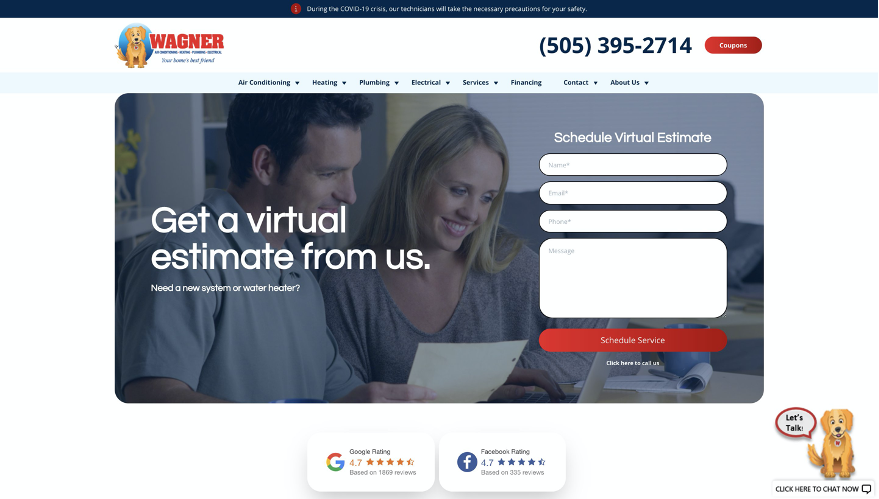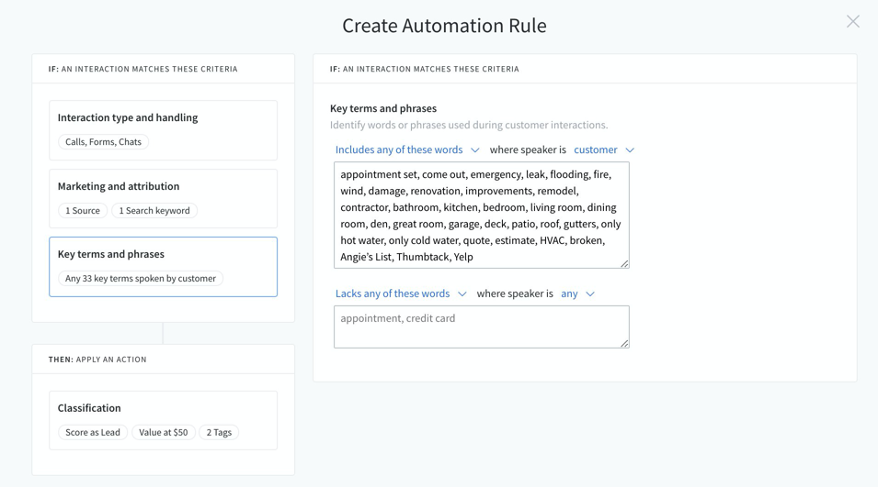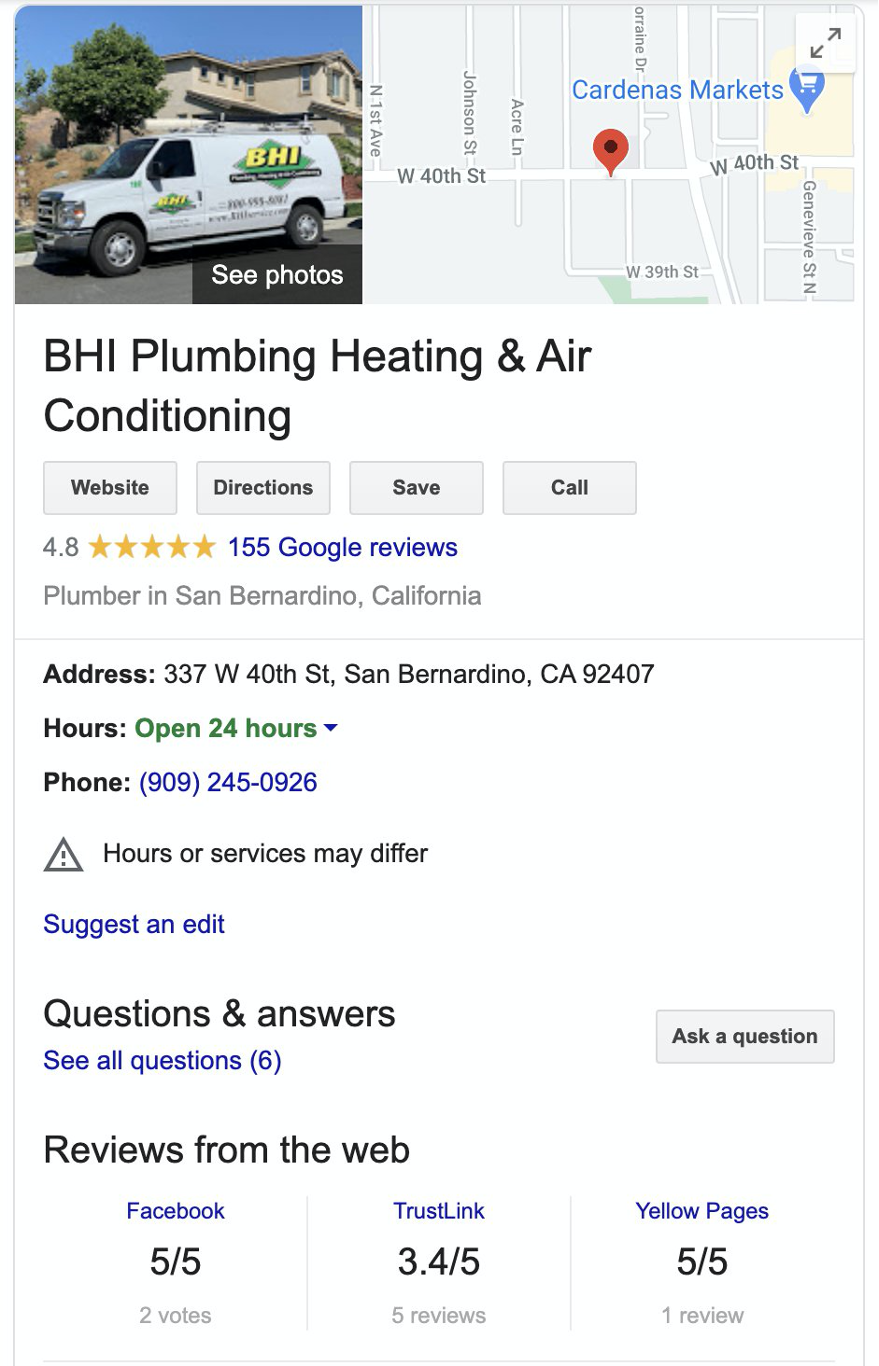Referrals may still be the ideal HVAC leads, but getting them is not as straightforward as it used to be. Word-of-mouth advertising has ventured online in the form of reviews. On top of that, online directories from Angie’s List to Thumbtack continue disrupting the home-improvement industry, promising to find ways to connect homeowners and service pros, with mixed results.
So how can contractors adjust to get more HVAC leads?
“Especially now, companies that are innovative about the types of services they offer and how they find new leads are the ones that are going to thrive in this changing environment,” says Roland Ligtenberg, cofounder and senior vice president of growth and innovation at Housecall Pro.
To help you be one of those innovative companies, we’ve rounded up these tips from home-services experts to help you generate more HVAC leads and qualify them faster.
1. Offer virtual estimates to find high-value HVAC leads fast.
Virtual estimates help you qualify HVAC leads faster than driving across town to do in-home estimates. The faster you qualify leads, the more potential customers you can connect with each day. That means better odds of finding the leads that generate the most revenue.
“We’ve seen HVAC companies thrive even during the lockdown by switching to virtual estimates,” Ligtenberg says.
Glenn Foltz of Foltz and Sons Electrical and Heating has offered virtual estimates via FaceTime for years. “I’ve saved myself a bunch of tire kickers and set myself apart for many of my clients!” Foltz tells Housecall Pro.
Houscall Pro’s guide on how to start offering virtual estimates shows how easy it is to set up. The main things you’ll need to define are:
- Which repairs you can confidently estimate virtually. For instance, estimating a new HVAC system’s cost can likely be accomplished by seeing the existing equipment and duct layout. Finding a refrigerant leak in the AC line, though, will probably require a service call.
- How customers book a virtual estimate and how they need to prepare. It’s fine if customers need to call to schedule a virtual estimate. But since those who request a virtual estimate are probably tech-savvy, it’s a good idea to offer online scheduling, too. It doesn’t have to be complex, either. Foltz and Sons uses a simple contact form on its main website, and appointment scheduling on its Facebook page.
- What technology you’ll use. FaceTime is easy to use, but keep in mind that not all of your customers will own an iPhone or iPad. Consider a free video calling tool, such as Zoom, that can work with your customers’ web browsers so they don’t have to download anything. Also consider a tool like Lead Center so you can follow up and schedule estimates before your customers call a competitor.
A strong example to follow is Wagner Mechanical’s virtual estimates landing page. It presents an online scheduling form and phone number together, letting customers choose their preferred contact method. From there, Wagner details what types of services it can and can’t estimate virtually, followed by how the process will work so customers know what to expect. It includes customer reviews, too, for social proof.
Of course, to capitalize on virtual estimates, you need to know which customers express interest on their calls and form submissions. That way, you can identify and qualify those leads for fast follow-up. Call tracking and form tracking help you do that.
- Pick call-tracking and form-tracking tools that help you automatically qualify leads. For instance, Conversation Intelligence (CI) adds several AI-powered upgrades to CallRail’s standard call-tracking and form-tracking software, including a tool called Automation Rules.
- Within Automation Rules, use keyword spotting to define important terms and phrases you want to identify in customer’s calls and form submissions, such as “virtual estimate.”
- Assign an action to the keyword “virtual estimate,” such as scoring the lead as qualified or tagging it as “New Customer,” so you know to prioritize that lead for follow-up.
You can even get insights into the value of your virtual versus in-person estimates. After following up with your HVAC leads, tag them as closed-won or closed-lost. Then, when you run a Keywords Spotted report, you’ll see how many leads you closed from “virtual estimate” compared with your other keywords. You can get an even deeper understanding by adding call values so you can see dollar values in CallRail reports.
2. Add call tracking to your Google My Business listing to better understand your organic HVAC leads.
Call tracking helps you pinpoint the quantity and quality of leads that come from your online and offline advertisements. This helps you make evidence-based decisions on how to adjust your marketing strategy.
CallRail’s Google My Business (GMB) integration helps here by adding call tracking to your GMB profile, one of your most important assets for attracting free HVAC leads. That’s because your free GMB profile puts you on Google Maps, Search, and other properties where customers can find you when they search.
But call tracking does more than show what customers call from your GMB profile. It also lets you listen to call recordings, collect contact information, and track GMB visitors across your site and marketing channels. This helps you go beyond measuring your marketing ROI to improving it. You can now update your website, ads, and keywords to better align with the journeys your customers take.
“It is a good idea to track the calls you get from your Google My Business profile. This will give you an idea of how your marketing efforts are doing,” says Stuart McHenry of BHI Plumbing, Heating & Air Conditioning in his article for Contracting Business. You need to add call tracking to your GMB listing the right way, though.
“There are two spots to add two different phone numbers in Google My Business,” McHenry says in his article. “The top spot should be your call tracking number. This number will also be visible and display on your listing. The second number should be your main business number.”
One last note on your GMB listing: Don’t stop at call tracking. The better your GMB profile’s quality, the higher you’ll appear in customers’ search results, including Google’s Local Pack. McHenry recommends optimizing your GMB profile for search by adding the following:
- Business information. This step is more involved than it seems because it affects all Google properties your business appears on. “The more time you put into setting up your business profile, the better the chances you will get more leads out of it,” McHenry says.
- Photos. Load high-quality images that represent your business well. Also make sure you load images into each category.
- Reviews. The more positive reviews your business has, the more it’ll attract HVAC leads. McHenry notes that HVAC contractors average just over 30 reviews.
- A post. GMB provides space for you to write and publish a short blog post. “Most businesses underutilize this function or don’t use it at all. This is a great place to highlight a new service or a promotion you are currently running,” McHenry says in his article.
For even more tips on optimizing your GMB profile to get more leads, check out the ultimate guide to Google My Business.
3. Claim other free business listings to improve search rankings and find which directories send you the best HVAC leads.
By setting up a strong Google My Business profile as outlined above, you create a template that helps you rapidly build free business listings on other directories, such as Yelp, Angie’s List, and Thumbtack. This does two things: First, it will help you rank higher in customers’ searches. Second, the leads that find you from these free listings will create quality samples of each directory. With that evidence, you’ll have a better feel for which directory is likely to send valuable leads—and which won’t—so you invest in the right one.
Each directory listing counts as a local citation. According to SEO tool Moz, local citations impact both search rankings and customer experience:
- The number of local citations you have, the accuracy of your local citations’ data, and the quality of the platforms your local citations appear on all factor into how high your HVAC business ranks in search.
- The more accurate your business data across your local citations, the easier it is for customers to discover you, get their questions answered, and ultimately decide to patronize your business.
The key to maximizing both local search rankings and customer experience lies in Name, Address, and Phone (NAP) consistency. Contractors who achieve high NAP consistency lay the foundation for strong local SEO rankings. Over time, these rankings trickle free HVAC leads as companies consistently surface in customers’ online searches. From there, improve your click-through(CTR) rate with tactics that make your business look more prominent to local leads, such as collecting more customer reviews.
The results of Housecall Pro’s survey of more than 140 home service companies show it’s worth investing time in lead generation strategies like these. “Every company we surveyed had gotten at least some leads from free sources, such as organic search results on Google, leads off of Facebook without paying for ads, or free listings on Thumbtack, Nextdoor, even Angie’s List,” Ligtenberg says. “Overall, it’s worth it to be listed everywhere you can—even if you’re not interested in paid advertising on those platforms.”
But what if you’re interested in paid platforms but want more data before deciding on which to invest in? It’s not recommended to create different tracking numbers for listings other than your Google My Business profile because it can reduce NAP consistency. The solution: track leads from your other directory listings by combining dynamic number insertion (DNI) with a website pool of session tracking numbers.
With CallRail, you can track any referral source callers come from—including directory listings such as Yelp—by combining dynamic number insertion (DNI) with website pools.
This feature lets you show a unique trackable phone number to leads when they visit your site from a directory listing. Now, you can see how those callers found you. From there, you can track first-time callers in CallRail’s analytics software to see which directory sends you the most organic leads. Now you have data to help you decide which directory might be worth investing in. After all, Housecall Pro’s survey shows that, while some trends are consistent, every company has to find what works best for itself.
“We found that HVAC, plumbing, and electrical companies were seeing the highest average monthly revenue from Google and the best ROI from Thumbtack,” Ligtenberg says. “We also discovered that Angie’s List and Yelp provided the lowest average ROI for HVAC, electric, and plumbing companies. But this isn’t always the case—every business is different. Some companies win big on Yelp simply because they’ve invested heavily there, and that’s where they have the most high ratings, and people know where to find them.”
Get started finding free business profiles to claim with our ultimate list of SEO directories, and learn more about local SEO with our advanced guide to NAP consistency.
4. Generate demand in your local community with affinity marketing.
Matt Michel, CEO of Service Roundtable, recommends affinity marketing to get more HVAC leads from your local community. As Michel notes in Contracting Business, affinity marketing costs time, not money. That makes it a great project to tackle during HVAC’s slow seasons.
Affinity marketing refers to partnering with another organization that represents a shared interest (that is, an affinity). Any organization that solicits dues or donations or relies on fundraising is a candidate for affinity marketing. To reach its members, the organization will likely require some sort of donation so it’s a mutually beneficial arrangement.
“Affinity marketing is beautiful because it piggybacks on existing emotional connections and does not require upfront financial investment. Like a commission, you only pay for business you receive,” Michel says in his article for Contracting Business.
Here’s an example Michel lays out for affinity marketing with a local Parent Teacher Association (PTA) chapter:
- Create coupons for students to take home to their parents.
- When parents use a coupon for an HVAC service, you make a donation to the PTA.
- Reward the class with most redeemed coupons with a pizza party.
There are plenty of potential affinity marketing partners out there, such as churches, homeowner associations (HOAs), veterans’ groups, youth sports clubs, and more. Though it takes time to build connections with these organizations, Michel points out that retaining the relationship is much easier. All that up-front work will set you up to do more affinity marketing campaigns with each organization in the future.
Increase your HVAC leads to make cashflow predictable
With these expert-recommended hacks, you’ll increase your number of HVAC leads and qualify them faster. Building a steady stream of predictable leads makes it that much easier to manage cashflow. When that’s in place, you can run experiments on your HVAC advertising to find what marketing efforts will best help you scale your business faster.











